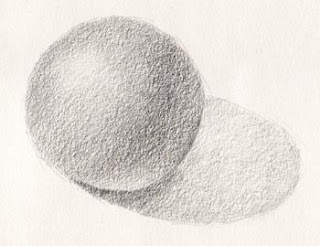How to Shade a Ball in Six Steps |
Practice shading a ball / sphere with this simple technique before moving on to more complicated subjects. (If you're new to drawing, read through Shading Basics before you begin.) |
Step One - Line DrawingQuickly draw the ball and its shadow using an overhand grip with light pressure on the pencil. Tip the pencil up on its point a bit, so that it makes a thinner line. The overhand grip is a good one for drawing quickly but it's not precise. You can see that my ball and shadow aren't perfect, and yours don't have to be either for this shading exercise to work. Just lightly draw a circle and try to get the shadow in about the same position as in the photo. |
Step Two - First ShadingUsing the same overhand grip, but lowering the angle of the pencil so that the full side of the lead is on the paper, very lightly shade the entire ball. Use short, back and forth hatching motions, all in the same direction, with a very light pressure on the pencil. |
Step Three - Define HighlightDefine the main highlight, near the top left of the ball, by shading the area around it to a slightly darker value. The highlight's edge is fuzzy and indistinct, s o make the hatching surrounding it uneven and the edges will look "soft". |
Step Four - Shade Main ShadowTake time to look at the most obvious shadow on the ball and notice that it's crescent shaped. It starts at the right top of the ball, above the cast shadow, and it ends at the bottom of the ball, near the left edge of the cast shadow. Shape the shadow as you shade it in by making several passes over the area until it darkens. To make sure the shading isn't getting too dark, squint your eyes at your drawing and compare it to the photo. |
Step Five - Add Subtle ShadingTo make the shading look more realistic, you'll need to add the more subtle shadows, too. Squint your eyes at both the photo and the drawing again. Since this shading method creates a rough texture, squinting your eyes will help you see it as smoother and more unified. |
Step Six - Shade Cast ShadowTo add the cast shadow, first take the time to observe that the shadow is darker than the ball at the bottom and is lighter than the ball near the top. Tip the pencil up on its point so you can hatch in the small area of the shadow under the ball, and then lower its angle again to graduate that value into the rest of the shadow. To finish, tip the pencil to its point and darken the right edge of the ball, slightly under the center point. Graduate that line into the body of the ball so that it will look "sharper" on the shadow side and "softer" on the ball side. Draw a sharp dark line underneath the ball's bottom edge in the same way, but blend this line into the shadow. thank you and we'll see again .. Assalammualaikum ..!! |

Khamis, 4 Ogos 2011
Langgan:
Catat Ulasan (Atom)







mentang2 ar da jd student ckgu isa skunk,bkn men agy dye ek,hehe
BalasPadam